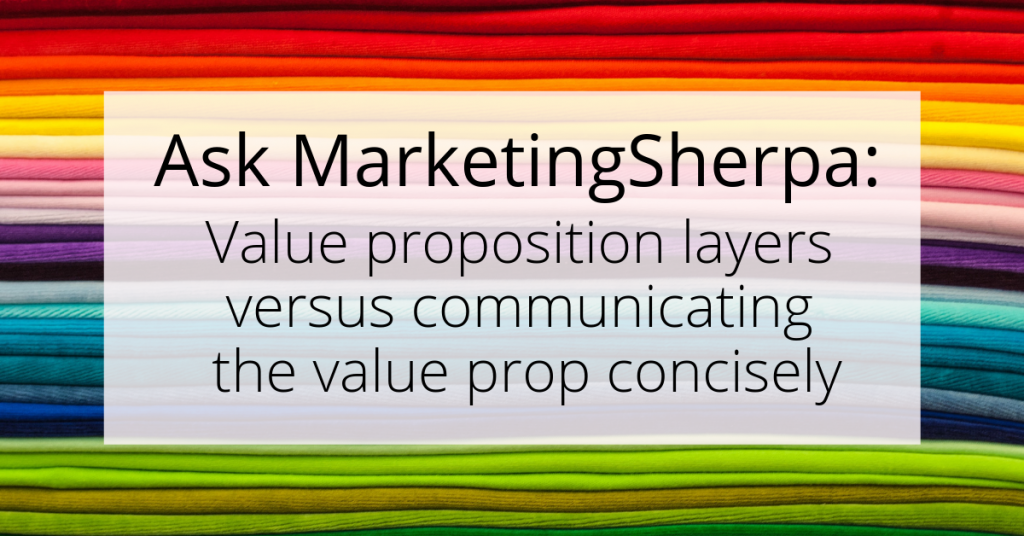Ask MarketingSherpa: Value proposition layers versus communicating the value prop concisely
We frequently receive questions from our email subscribers asking marketing advice. Instead of hiding those answers in a one-to-one email communication, we occasionally publish edited excerpts of some of them here on the MarketingSherpa blog so they can help other readers as well. If you have any questions, let us know.
Dear MarketingSherpa: Thanks for the great resources. I have been in touch in the hopes of getting some direct support around our value proposition.
We’ve taken insights from the Value Proposition course (and Flint’s new book) and redesigned our site (note, we haven’t yet implemented these new designs).
Is it common to present the value proposition in layers or should it be communicated more concisely? How early in the user journey should the value proposition be presented? Is it typically done on the homepage? Do you have examples of companies successfully implementing the value proposition in this way? How did they guide users through the value prop from the homepage?
Thanks so much for your insights!
Dear Reader: Thanks for your email, and glad to hear you’re working on getting some direct support.
I’m also glad to hear you’ve taken some insights from the value prop course and Marketer as Philosopher book for your site redesign. If you’d ever like to share some of that work publicly to help other marketers and product managers and get some recognition for you and your team, please let me know. Happy to consider it for a MarketingSherpa article. Here are some examples:
- Email Marketing: Wholesale distributor updates email signup and preference center, increases form submissions 120%
- Small Business Social Media Advertising: Local shop conducts value proposition testing with Facebook ads
- Email Marketing: The Darth Vader pizza email
Is it common to present the value proposition in layers or should it be communicated more concisely?
It depends on how complex the customer journey and sales process is. For very simple products, it usually isn’t necessary. But anything with any level of complexity usually requires communicating the value proposition in layers.
To give marketers and businesses a clear step-by-step approach to address this challenge, we created this infographic:
How early in the user journey should the value proposition be presented?
Levels of value should be communicated to the customer from the very first touchpoint. That doesn’t mean you necessarily start with the primary value proposition. You should understand the four essential levels of value, and what value should be communicated at each customer touchpoint.
So, in essence, the value prop should start being communicated before the customer ever gets to the website, in the channel. Here are some tips for channel testing:
Is it typically done on the homepage?
While you need to communicate the value proposition on the homepage, the customer may not necessarily go straight to the homepage to understand the value proposition when you want them to.
It helps to map out the prospect conclusion funnel. Here is some information to help you do that:
What does the customer need to know to make a decision about your product? And when do they need to know it? And realize, there is likely more than one unitary path your customers will take. Based on the type of product they’re looking for, their age or income, company size, their content modality preference, and dozens and dozens of other factors, there are many paths potential customers travel down as they make their purchase decisions.
But all roads lead to an ultimate decision point — where they either decide to buy your product or not.
You must communicate elements of the four essential levels of value so they decide to keep moving along the path, and ultimately decide to trust your brand with their purchase.
Do you have examples of companies successfully implementing the value proposition in this way?
Using a specific company’s landing page (that also essentially served as the company’s homepage) as an example, here’s how to use the Value Sequencing Decider Graphic:
As you’ll see in the example, the treatment (a longer landing page) performed better than the control because it communicated more value.
How did they guide users through the value prop from the homepage?
Here is another example, for a homepage specifically. In this case study, you can see how the team structured the layout to help visitors absorb the product’s value and benefits:
You can follow Daniel Burstein, Senior Director, Content & Marketing, MarketingSherpa and MECLABS Institute, on Twitter @DanielBurstein.
You might also like …
MECLABS Institute Value Proposition Development on-demand certification course — discover the drivers that motivate a person to say “yes”
Powerful Value Propositions: How to Optimize this Critical Marketing Element — and Lift Your Results
Value Force: How to win on value proposition and not just price
Categories: Marketing, Value Proposition conversion optimization, digital marketing, landing page optimization, marketing insights, marketing strategy, Online Marketing, Value Proposition










